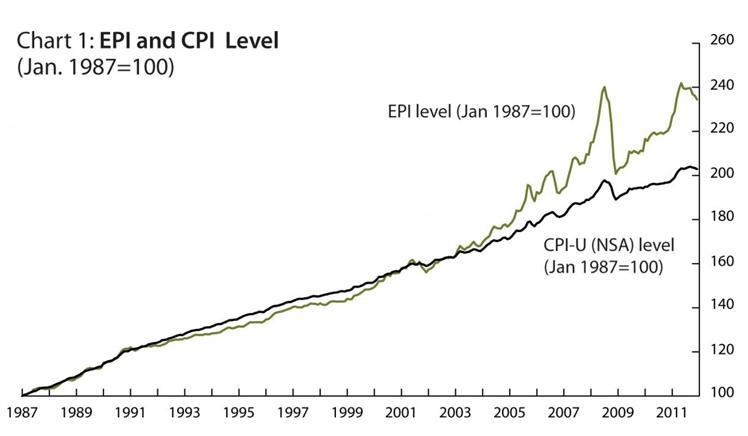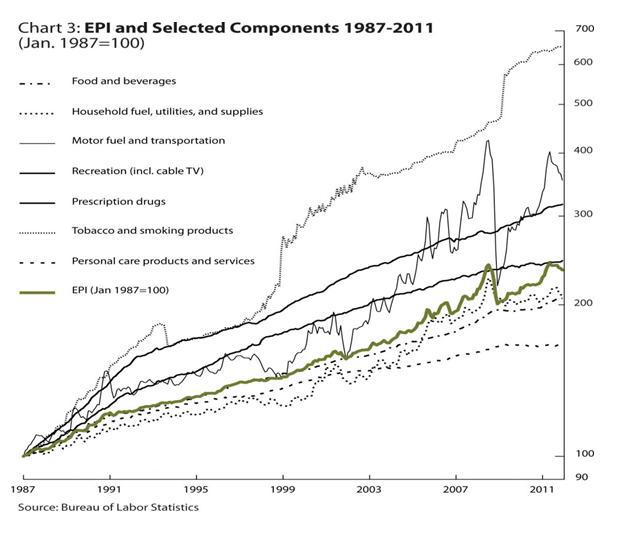"Most Americans in 2011 experienced a day-to-day inflation rate of 7.2 percent-more than two times the official estimate released by the Bureau of Labor Statistics." -- AEIR
The American Institute For Economic Research (AIER) has done investors and consumers an important service. They have compiled an index that actually reflects the way we live, eschewing the government's "hedonic quality adjustments" (that's when they basically say, "Well, yes, dresses cost more this year, but since the buttons are of better quality, we adjust that increase downward") or the "owners' equivalent rent" in lieu of home prices, and all the other little tricks of the trade that too often render the CPI the equivalent of the punch line of the old accountant joke: "4 + 4? How much do you want it to be?"
The CPI is used to determine Cost of Living Adjustments and other yardsticks that determine how and when people living on a fixed income get an increase. It affects other interest rates as well as banks' willingness to lend at reasonable rates or pay their depositors a fair rate. The problem is, while I imagine the Bureau of Labor Statistics tries to measure things right, it probably doesn't measure the right things.
Take a senior couple living on a fixed income; they typify the consumers who most clearly need a realistic cost of living adjustment from the Social Security they paid into over their lifetimes, or their company pensions, or the CDs, bonds and preferreds they buy for a little extra income boost. And the CPI often understates real inflation and keeps all these savings rates artificially depressed.
On the other hand, the CPI measures a lot of things many people buy only occasionally. Using our senior couple as an example, they may not drive as much as they used to. Maybe they only put 8,000 miles a year on their car instead of the 15,000 they might have more typically driven when traveling on business or taking more frequent road trips, etc. It seems reasonable they might keep their car for ten years instead of five. Yet the CPI measures the cost of automobiles as if they were an annual purchase. This same couple might have their home fully paid for. "Owners' equivalent rent" isn't their issue. Their appliances work every bit as well as they did five years ago so they aren't likely to rush out and buy new ones. Yet the CPI treats appliances and furniture as if we all are in a mad dash to replace the contents of our home rather more frequently than we really are.
The EPI developed by AEIR, on the other hand, reflects basic economic change that we all see every day. Here's a chart that shows the rate of increase in the CPI over the past quarter-century. The green line shows the EPI, presenting a very different picture, the picture every American feels in their wallet and knows in their heart to be reflective of our daily living. (All charts courtesy of AEIR.)
What makes these two indexes different? According to the BLS, "the CPI represents all goods and services purchased for consumption by the reference population… BLS has classified all expenditure items into more than 200 categories, arranged into eight major groups. Major groups and examples of categories in each are as follows:
· FOOD AND BEVERAGES (breakfast cereal, milk, coffee, chicken, wine, full service meals, snacks)
· HOUSING (rent of primary residence, owners' equivalent rent, fuel oil, bedroom furniture)
· APPAREL (men's shirts and sweaters, women's dresses, jewelry)
· TRANSPORTATION (new vehicles, airline fares, gasoline, motor vehicle insurance)
· MEDICAL CARE (prescription drugs and medical supplies, physicians' services, eyeglasses and eye care, hospital services)
· RECREATION (televisions, toys, pets and pet products, sports equipment, admissions);
· EDUCATION AND COMMUNICATION (college tuition, postage, telephone services, computer software and accessories);
· OTHER GOODS AND SERVICES (tobacco and smoking products, haircuts and other personal services, funeral expenses)."
However. When reporting CPI, the BLS typically excludes food, beverages, and energy (under "Transportation") because they are too volatile.
What?!?!? If food and gas are skyrocketing, why exclude them just because they're volatile? This is where we live and that is what we spend money on. The fact that computers and software, items we might purchase once a year or less, have declined in value doesn't help one bit if every meal and every gas fill-up are breaking the bank. Yet the BLS website goes on to say, "The CPI measures inflation as experienced by consumers in their day-to-day living expenses."
How does this square with the fact that EPI shows what we all suspected when we saw the dollars flying out of our wallets and purses - that the cost of living in 2011 was more than double what the BLS claims it to be? Even a cursory glance at the chart below tells the story.
You cannot simply exclude food and the means to transport yourself from Point A to Point B and hope to have anything akin to an accurate picture.
Every day we spend money on food, drink, and transportation. Other items, not so much.
For instance, the price of smoking cigarettes and using other tobacco products has soared 600% in 25 years, but with fewer and fewer of us smoking, most Americans' "personal" everyday price index doesn't go up at all because of this. But the energy we use to heat or cool our homes, keep the lights on at night, power our TVs and computers, and transport ourselves to work and back affect every single one of us. And those costs have skyrocketed over the years and average between 14 and 20% of the average household's total budget.
As consumers, if we are serious about reducing our expenses, we will attempt to rein in the every-single-day expenses that make up a huge portion of our total living expenses. Which is more important - the fact that a new refrigerator costs only $50 more than our old one (but has more gee-gaws and so is considered "flat" in price by the CPI) or the $500 a month it costs to heat our home in winter or the $60 and rising cost it takes to fill a 15-gallon tank with gasoline a couple times a week?
As investors, the path is clear. As long as the CPI depresses cost of living adjustments, the government saves hugely on payouts to retirees, meaning you don't want to count on Social Security to honestly reflect what your daily living reality is. You need to invest in something that pays better than "flat" year on year! You could turn to bonds, except that bonds reflect the CPI in other, albeit more subtle ways. If there is no inflation - the government told us so - then there is no demand for a greater return from fixed income investments.
On the other hand, our current government actions to demonize one of Mother Nature's many wondrous gifts to us - the "storage batteries" placed around the earth in the form of oil, gas, and coal reserves - has led directly to the current shortages and high prices for these fuels. Add in the possibility of world turmoil, which causes large users of these fuels, such as utilities and transportation companies, to contract to hoard reliable supplies, and you create the Perfect Storm for higher fuel prices.
While I don't want this discussion to degenerate into a political debate from those with entrenched positions on either side, I think we can all agree that among these, we must include billions of dollars to subsidize pie-in-the-sky technologies as yet unproven that promise "green" energy even if the energy in is greater than the energy out! We must also include the decision to force Canadian oil sands fuels to be diverted to China so our political class can pander to a part of its base that would rather freeze in the dark with no access - horreurs! - to their iPhone or iPad than allow a pipeline to deliver that precious resource to Americans.
And the clever decision to "allow drilling" in the Gulf of Mexico but extend the permitting process interminably so no one can actually drill is political genius, if economic suicide to those of us now encumbered by the results of these follies.
Since I see no return to common sense on the immediate horizon, may I suggest you look where that conclusion leads: international drilling companies that will continue finding oil and gas for China, India, Russia, Brazil, Indonesia and the rest of the emerging world, if not for or in the US. This means companies based in the US but contracting to more enlightened governments as well as those based elsewhere.
In our own portfolios, Seadrill (SDRL - Norway) and Schlumberger (SLB - France and the US) are good examples. Though I would wait for a pullback to add to our own positions in either (we own SDRL at 24 and SLB at 68) after you perform your own due diligence you may wish to take a pilot position even at these levels. Other players I like include Noble Energy (NBL) and Delek Group (DGRLY.PK) which (through its subsidiaries) are jointly developing the massive and aptly-named Leviathan field off Israeli waters in the Mediterranean. I think the latter is well-priced right now.
Less attractive to me right now, but at a lower price compelling, would be Baker Hughes (BHI), Halliburton (HAL), and (also in our portfolio) Weatherford Intl (WFT) and Atwood Oceanics (ATW). North Atlantic Drilling (NATDF.PK) could be a great one if they get the government tax liability case negotiated to a successful conclusion.
For those who'd rather buy the producers, all are well-priced today but on pullbacks we'll be buyers of Exxon (XOM), Total (TOT), Chevron (CVX), Conoco (COP), Imperial Oil (IMO), Cenovus (CVE), and Repsol (REPYY.PK).
THE FINE PRINT: As Registered Investment Advisors, we see it as our responsibility to advise the following: we do not know your personal financial situation, so the information contained in this communiqué represents the opinions of the staff of Stanford Wealth Management, and should not be construed as personalized investment advice.
Past performance is no guarantee of future results, rather an obvious statement but clearly too often unheeded judging by the number of investors who buy the current #1 mutual fund only to watch it plummet next month.
We encourage you to do your own research on individual issues we recommend for your analysis to see if they might be of value in your own investing. We take our responsibility to proffer intelligent commentary seriously, but it should not be assumed that investing in any securities we are investing in will always be profitable. We do our best to get it right, and we "eat our own cooking," but we could be wrong, hence our full disclosure as to whether we own or are buying the investments we write about.
- English (UK)
- English (India)
- English (Canada)
- English (Australia)
- English (South Africa)
- English (Philippines)
- English (Nigeria)
- Deutsch
- Español (España)
- Español (México)
- Français
- Italiano
- Nederlands
- Português (Portugal)
- Polski
- Português (Brasil)
- Русский
- Türkçe
- العربية
- Ελληνικά
- Svenska
- Suomi
- עברית
- 日本語
- 한국어
- 简体中文
- 繁體中文
- Bahasa Indonesia
- Bahasa Melayu
- ไทย
- Tiếng Việt
- हिंदी
Forget The CPI, Use This Index and Profit From This Sector
Published 03/05/2012, 02:16 AM
Updated 07/09/2023, 06:31 AM
Forget The CPI, Use This Index and Profit From This Sector
3rd party Ad. Not an offer or recommendation by Investing.com. See disclosure here or
remove ads
.
Latest comments
Install Our App
Risk Disclosure: Trading in financial instruments and/or cryptocurrencies involves high risks including the risk of losing some, or all, of your investment amount, and may not be suitable for all investors. Prices of cryptocurrencies are extremely volatile and may be affected by external factors such as financial, regulatory or political events. Trading on margin increases the financial risks.
Before deciding to trade in financial instrument or cryptocurrencies you should be fully informed of the risks and costs associated with trading the financial markets, carefully consider your investment objectives, level of experience, and risk appetite, and seek professional advice where needed.
Fusion Media would like to remind you that the data contained in this website is not necessarily real-time nor accurate. The data and prices on the website are not necessarily provided by any market or exchange, but may be provided by market makers, and so prices may not be accurate and may differ from the actual price at any given market, meaning prices are indicative and not appropriate for trading purposes. Fusion Media and any provider of the data contained in this website will not accept liability for any loss or damage as a result of your trading, or your reliance on the information contained within this website.
It is prohibited to use, store, reproduce, display, modify, transmit or distribute the data contained in this website without the explicit prior written permission of Fusion Media and/or the data provider. All intellectual property rights are reserved by the providers and/or the exchange providing the data contained in this website.
Fusion Media may be compensated by the advertisers that appear on the website, based on your interaction with the advertisements or advertisers.
Before deciding to trade in financial instrument or cryptocurrencies you should be fully informed of the risks and costs associated with trading the financial markets, carefully consider your investment objectives, level of experience, and risk appetite, and seek professional advice where needed.
Fusion Media would like to remind you that the data contained in this website is not necessarily real-time nor accurate. The data and prices on the website are not necessarily provided by any market or exchange, but may be provided by market makers, and so prices may not be accurate and may differ from the actual price at any given market, meaning prices are indicative and not appropriate for trading purposes. Fusion Media and any provider of the data contained in this website will not accept liability for any loss or damage as a result of your trading, or your reliance on the information contained within this website.
It is prohibited to use, store, reproduce, display, modify, transmit or distribute the data contained in this website without the explicit prior written permission of Fusion Media and/or the data provider. All intellectual property rights are reserved by the providers and/or the exchange providing the data contained in this website.
Fusion Media may be compensated by the advertisers that appear on the website, based on your interaction with the advertisements or advertisers.
© 2007-2024 - Fusion Media Limited. All Rights Reserved.
